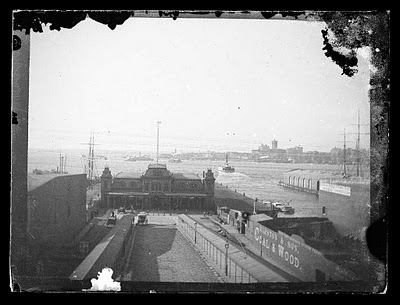"Beneath these streets and vacant lots lie the remainder of those brave sons of Maryland."
quote is taken from The Stone House of Gowanus by Georgia Fraser, 1909.)*
 |
| "Maryland Willow of the Gowanus"- Mixed Media on shopping bag paper and ink jet print. 86"x96", 2012 |
Here is a great link for more information about Maryland regiment and the battle.
It is a pictorial idea that I have have been developing for sometime.It came about with my reading of the e-book The Stone House of Gowanus by Georgia Fraser, 1909. Her book is about the long history of the old Vecht-Cortelyou house. The house was the center of the fighting during the Battle of Long Island in 1776. Near the end of her book there is a photograph of a lone willow tree in the vacant lot where the house once stood. (pp.129) The author clam's that it is the same willow that is depicted in old paintings of the house. I am not so sure of that, however, I became fascinated by the idea of a old Willow tree that links us back to the times of 1776. The author described the tree as being the same one depicted standing at the door way of the original stone house.I can understand her enthusiasm for proposing this tree as a link to the battle. After all in Brooklyn, there is no physical evidence of the battle.The landscape has been totally re-engineered to such a point that no natural feature is the same as it was in 1776. Perhaps the only places that exist today that are the least unchanged are in Green Wood and Evergreen cemeteries.
Of course when the willow photograph was made 1909, the original house being demolished long before, I don't believe could not have been the same one that Georgia thought it was. But it did start me thinking about creating tangible links to the past. My work is largely about the fact that nature can be our conduit through time.How it operates on a different scale of time, than us humans do. Tress live for many human generations and are often known as "witness tress. Witness trees, as designated by the National Park Service, are long-standing trees that have "witnessed" key events, trends, and people in American history.**
 |
| This earlier photo shows the house from the front. Maybe the willow tree is the one on the left side out side of the fence? |
I gravitated to the image of the willow, because it offers a beautiful metaphor of not only describing time, but also the local environment. Willows like to grow near water, something that is abundant in the tidal Gowanus area.Design wise, the leaf is also a beautiful structure.I used this structure in the writing out of the names on the leaves. Below are earlier artwork that show the evolution towards the final painting. The final picture was finished over the summer in time for Go Brooklyn event.
 |
| This is an early unfinished 2010 painting taken from the image in Georgia's book. Mixed media on ply wood.33"x48" 2010-2011. At this point I cut out leaf shapes and randomly wrote out names. |
 |
| Detail of the lower half of the painting. |
 |
| Detail of the upper half showing soildres names on leaves. |
 |
| Deatil |
 |
| I tried out a couple of different arrangements of leaf patterns. I used pins to hold the leaves in place until I was satisfied with there arrangement. |
"CONSTANTLY PURSUING THAT ARRANT THIEF, OBLIVION, AS HE STEALS INTO INFINITE DARKNESS WITH THE PRICELESS HISTORIES OF OUR LAND, THE ANTIQUARY HASTENS TO SNATCH SOME OF THE FLEETING MEMORIALS FROM HIS HANDS "—FIELD*. (I am not sure who Field is. But the quote is taken from The Stone House of Gowanus by Georgia Fraser, 1909.)*
**http://www.witnesstreeproject.org/aboutwtp/
























